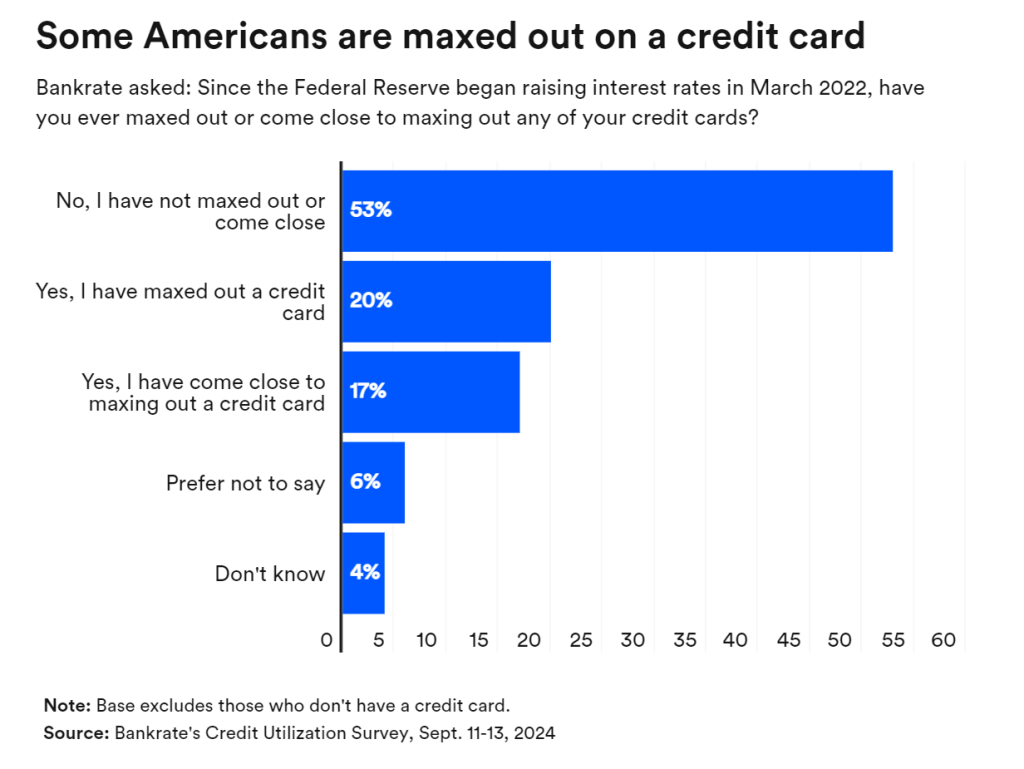Bankrate has some interesting stats on credit card usage. Let’s take a look.

Please consider Nearly 2 in 5 cardholders have maxed out a credit card or come close since the Fed started raising interest rates.
Key Findings
- Credit Crunch: Nearly 2 in 5 cardholders (37%) have maxed out a credit card or come close since the Fed started raising interest rates, Bankrate’s Credit Utilization Survey found. That includes 20% who have maxed out a credit card and 17% who have come close to maxing one out.
- Credit cards are becoming Americans’ lifelines against high inflation: Over half of cardholders who’ve maxed out a credit card or come close (54%) blame inflation or high prices. Other top reasons include emergency expenses (38%) and carrying a balance or having credit card debt (32%).
- Maxing out and feeling the pinch: Of those who have maxed out their credit card or come close, 88% say it negatively impacted their personal finances in some way. This includes 41% who said their credit score declined and 31% who say they could not afford a necessary expense.
Utilization rates at an aggregate, nationwide level seem stable, even as credit card debt hit a new record of $1.14 trillion in the second quarter of 2024, according to the New York Fed’s Household Debt and Credit Report. The average credit card utilization rate was 21.3 percent in August, in line with a historic norm since 2011 of 20-22 percent and below the 30 percent rule-of-thumb that experts typically recommend, according to Equifax data.
Bankrate’s findings, however, offer a closer examination, revealing that some pockets of distress could be forming as some groups — particularly those who have been vulnerable to inflation — utilize more credit than others. Equifax data also shows that utilization rates have surged from where they stood in March 2022 (18.6 percent). Back in April 2021, meanwhile, the average utilization rate hit the lowest levels ever recorded (18 percent).
The youngest Americans — Generation Z cardholders (ages 18-27) — are more likely to have lower credit limits that lead to higher utilization rates, partially a feature of being new in their financial journey, according to New York Fed research. Yet, they are the least likely to report having maxed out a card (at 10 percent), though the most likely of the generations to have come close (at 21 percent), according to Bankrate’s survey.
Many households had no choice but to take on credit card debt — at a time when the cost of carrying a balance surged to the highest levels ever recorded. Just 44 percent of Americans say they would pay an unexpected $1,000 expense with cash from their savings account, according to Bankrate’s Emergency Savings Survey.
Black Americans (41 percent) and Hispanic (39 percent) Americans are most likely to have missed at least one payment due to a financial reason since the start of the year, compared with 27 percent of White Americans.
Millennials, meanwhile, are the most likely of the generations to have missed a bill for a financial reason since the start of the year, at 42 percent, followed by 34 percent for both Gen Zers and Gen Xers and 17 percent of baby boomers.
Pockets of Distress
I have been discussing “pockets of distress” all year.
Bankrate confirms the same groups I have been discussing: Younger adults, blacks, and the renters (non-asset holders).
My base case since early this year has been that how this group breaks will decide the election.
Trump’s Polling Momentum Is Real With Under Three Weeks to Go
Harris had huge momentum after Trump completely blew the debate. But little by little, Trump has gained.
I believe the economy is behind the move.
For discussion, please see Trump’s Polling Momentum Is Real With Under Three Weeks to Go
Momentum usually does not change unless there is an event. In football that might be an interception or a fumble. Now it could be anything, even something we don’t easily see.
That something most economists don’t see is the economy. For 67 percent of the nation (the asset holders and the home owners), the economy (the stock market) has been good to very good, offsetting inflation.
For the renters and struggling homeowners fed up with property insurance, food, and other inflation, the economy borders on miserable.
Who is that? Young voters, blacks, and those without a college education.
If you own stocks or refinanced your house at 3.0 percent, you likely are better off. And that’s a big majority. But that’s not who will decide the election. And it is a big part of why Harris is struggling.
If you want to understands Trump’s gains among black voters and young voters, look at credit card stress and inflation.